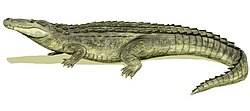| Alligator mefferdi Temporal range: Miocene, | |
|---|---|
| Scientific classification | |
| Kingdom: | Animalia |
| Phylum: | Chordata |
| Class: | Reptilia |
| Clade: | Archosauria |
| Order: | Crocodilia |
| Superfamily: | Alligatoroidea |
| Family: | Alligatoridae |
| Subfamily: | Alligatorinae |
| Genus: | Alligator |
| Species: | †A. mefferdi |
| Binomial name | |
| †Alligator mefferdi C.C. Mook, 1946 | |
Alligator mefferdi is an extinct species of alligator described by Charles Craig Mook. They lived in the Miocene period, and their range was principally in what is now Nebraska, United States. [2] [3] The type specimen was discovered in the Ash Hollow Formation at Ash Hollow State Historical Park. [2]


